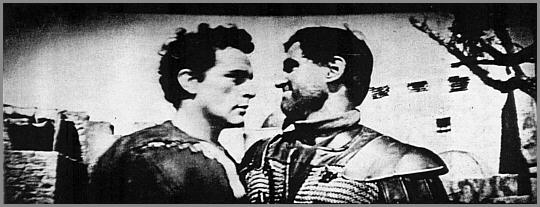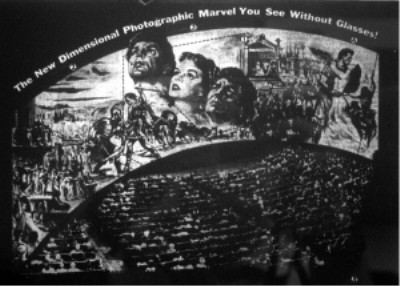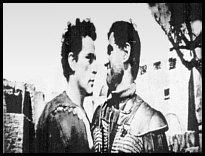| |
The Robe, First Widescreen Film in Utah
On 1 October 1953, the Lyric and the Villa became the first theaters in
the Salt Lake area to show widescreen movies with stereo sound. Both theaters
showed The Robe, the first movie filmed in a new process called
CinemaScope. The Lyric later became the Promised Valley Playhouse.
|
. . . a screen
so large a viewer has to turn his head to see from end to end .
. .
CinemaScope,
the new movie process which was introduced with "The Robe,"
is quite as impressive as the picture itself. It projects
to the audience a panorama bigger than life itself.
Looking at the
wide, curved screens, viewers have the impression they are part
of the picture. The sound, emanating from where it is spoken,
is another feature that's interesting, new and intriguing. Whatever
faults, a slight blur at times, a slight buzz in the sound, are
more than compensated for by the over-all splendor of the new CinemaScope
screen.
"The Robe"
and CinemaScope, now on view at the Lyric and Villa Theaters, truly
are experiences that should not be missed.
Deseret
News, 1 October 1953
|
| |
|
|
No. 1 shows how the flat ordinary
screen is dwarfed by the newly created curved Miracle Mirror Screen. Nos.
2, 3, 4 show how CinemaScope's superior new Stereophonic Sound,
enhances the scope of the audience participation. No.
5 shows how the new Anamorphic Lens creates infinite depth and
life-like reality to engulf you in the action on the screen.
From
the opening day ad for The Robe, Deseret News, 1 October 1953.
|
After the debut of Cinerama in 1952, studio executives raced to develop
a similar widescreen process. 20th Century Fox acquired world rights to
Anamorphoscope, a filming process developed by Prof. Henri Chrétien,
and renamed it CinemaScope.
CinemaScope used an anamorphic lens to squeeze a wide image onto traditional
35mm film during filming. Movie theaters were equipped with large wide
screens, with a slight curve, and then the image was stretched back out
using another lens. The result was an image twice as wide as traditional
movies, without the extra complication and expense of using three separate
cameras and projectors as with Cinerama.
|
|
A squeezed frame from The Robe, as it appears on the film.
|
 |
The same frame, as it appears on the screen.
Images courtesy of The American WideScreen Museum
- www.widescreenmuseum.com
|
CinemaScope also provided stereo sound using four magnetic tracks on
either sides of the sprocket holes. Three channels of sound were behind
the screen and the fourth used speakers on the side and rear walls of
the auditorium. Although movie studios expected this stereo sound format
to become the standard, movie theaters operators resisted the high expense
and an optical mono soundtrack was later added to CinemaScope prints.
Although the term CinemaScope is not longer used, many widescreen films
today use the anamorphic process. It is referred to now simply
as "scope."
|
|


